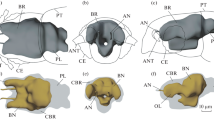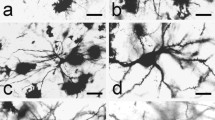Summary
The structural organization of the corpora pedunculata in the brain of different insects (Apis mellifica, Formica polyctena, Acheta domesticus, Periplaneta americana) has been investigated by means of light and electron microscopical techniques. Based on morphology some functional implications are discussed:
-
1.
The input and the output of activity due to extrinsic fibres takes place in seperate neuropile areas (calyces and lobes).
-
2.
The corpora pedunculata represent a multi-channel-system of intrinsic fibres with respect to the afferent and efferent pathways of extrinsic fibres.
-
3.
Intrinsic fibres are connected by synapses. These synaptic connexions may serve for special integrative properties of the corpora pedunculata system.
-
4.
The peculiar form of the corpora pedunculata due to the pedunculi and lobes is discussed as a special arrangement of neurons for transposition of synaptic distances into sequential activation or inhibition of nerve fibres.
-
5.
The corpora pedunculata system is compared with the cerebellum of vertebrates.
Similar content being viewed by others
Literatur
Akert, K., Steiger, U.: Über Glomeruli im Zentralnervensystem von Vertebraten und Invertebraten. Schweiz. Arch. Neurol. Neurochir. Psychiat. 100, 321–337 (1967)
Alten, H.v.: Zur Phylogenie des Hymenopterengehirns. Jena. Z. Med. Naturw. 46, 511–590 (1910)
Boeckh, J., Sandri, C., Akert, K.: Sensorische Eingänge und synaptische Verbindungen im Zentralnervensystem von Insekten. Z. Zellforsch. 103, 429–446 (1970)
Braitenberg, V.: Functional interpretation of cerebellar histology. Nature (Lond.) 190, 539–540 (1961)
Braitenberg, V.: Is the cerebellar cortex a biological clock in the millisecond range? In: C.A. Fox and R.S. Snider (eds.), The cerebellum, Progress in brain research. Vol. 25, p. 334–346. Amsterdam: Elsevier 1967
Braitenberg, V., Onesto, N.: The cerebellar cortex as a timing organ. Discussion of an hypothesis. Proc. 1st. Int. Conf. Med. Cybernet., Naples, Giannini, p. 1–19 (1962)
Brun, R.: Vergleichende Untersuchungen über Insektengehirne mit besonderer Berücksichtigung der pilzhutförmigen Körper. Schweiz. Arch. Neurol. Psychiat. 13, 144–172 (1923)
Brun, R.: Zur Frage der sog. „Ocellarglomeruli” und der efferenten Verbindungen der pilzhutförmigen Körper des Insektengehirns, speziell bei den sozialen Hymenopteren. Zool. Anz. 97, 145–155 (1932)
Bullock, T.H., Horridge, G.A.: Structure and function in the nervous system of invertebrates, vol. II. San Francisco-London: Freeman 1965
Cajal, S.R.: Histologie du Système Nerveux de l'Homme et des Vertébrés. Tome II. 993 pp. Paris: Maloine 1911
Cajal, S.R., Sanchez, D.: Contribucion al conocimiento de los centros nerviosos de los insectos. Parte I, retina y centros opticos. Trab. Lab. Invest. Biol. Univ. Madr. 13, 1–168 (1915)
Cohen, M.J.: The function of receptors in the statocyst of the lobster Homarus americanus. J. Physiol. (Lond.) 130, 9–34 (1955)
Dow, R.S.: Action potentials of cerebellar cortex in response to local electrical stimulation. J. Neurophysiol. 12, 245–256 (1949)
Dujardin, F.: Mémoire sur le système nerveux des insectes. Ann. sci. nat. (Zool.) Paris (3) 14, 195–205 (1850)
Eccles, J.C., Ito, M., Szentágothai, J.: The cerebellum as a neuronal machine. Berlin-Heidelberg-New York: Springer 1967
Elsner, N., Huber, F.: Die Organisation des Werbegesanges der Heuschrecke Gomphocerippus rufus L. in Abhängigkeit von zentralen und peripheren Bedingungen. Z. vergl. Physiol. 65, 389–423 (1969)
Floegel, J.H.L.: Über den einheitlichen Bau des Gehirns in den verschiedenen InsectenOrdnungen. Z. wiss. Zool. Suppl. 30, 556–592 (1878)
Florey, E.: Lehrbuch der Tierphysiologie. Stuttgart: Thieme 1970
Forel, A.: Die psychischen Fähigkeiten der Ameisen und einiger anderer Insekten. Vortr. V. Int. Zool. Kongr. Berlin 1901. pp. 57 (4. Aufl.). München: Reinhardt 1907
Freeman, J.A.: The cerebellum as a timing device: An experimental study in the frog. In: R.R. Llinás (ed.), Neurobiology of cerebellar evolution and development, p. 397–420. Chicago: American Medical Association 1969
Frontali, N., Mancini, G.: Studies on the neuronal organization of cockroach corpora pedunculata. J. Insect Physiol. 16, 2293–2301 (1970)
Goll, W.: Strukturuntersuchungen am Gehirn von Formica. Z. Morph. Ökol. Tiere 59, 143–210 (1967)
Goossen, H.: Untersuchungen an Gehirnen verschieden großer jeweils verwandter Coleopterenund Hymenopterenarten. Zool. Jb., Abt. Allg. Zool. 62, 1–64 (1949)
Hanström, B.: Vergleichende Anatomie des Nervensystems der wirbellosen Tiere. Berlin: Springer 1928
Howse, P.E., Williams, J.L.D.: The brains of social insects in relation to behaviour. Proc. VI Congr. IUSSI, Bern, 59–64 (1969)
Huber, F.: Sitz und Bedeutung nervöser Zentren für Instinkthandlungen beim Männchen von Gryllus campestris L. Z. Tierpsychol. 12, 12–48 (1955a)
Huber, F.: Über die Funktion der Pilzkörper (Corpora pedunculata) beim Gesang der Keulenheuschrecke Gomphocerus rufus L. Acrididae. Naturwissenschaften 42, 566–567 (1955b)
Huber, F.: Auslösung von Bewegungsmustern durch elektrische Reizung des Oberschlundganglions bei Orthopteren (Saltatoria: Gryllidae, Acrididae). Verh. Zool. Ges. Münster. Zool. Anz. Suppl. 23, 248–269 (1959)
Huber, F.: Experimentelle Untersuchungen zur nervösen Atmungsregulation der Orthopteren (Saltatoria: Gryllidae). Z. vergl. Physiol. 43, 359–391 (1960a)
Huber, F.: Untersuchungen über die Funktion des Zentralnervensystems und insbesondere des Gehirns bei der Fortbewegung und Lauterzeugung der Grillen. Z. vergl. Physiol. 44, 60–132 (1960b)
Huber, F.: Neural integration (central nervous system). In: M. Rockstein (ed.), The physiology of insecta. Vol. 2, p. 333–406. New York: Academic Press 1965
Huber, F.: Neuronal background of species-specific acoustical communication in orthopteran insects (Gryllidae). In: The biology of brains. London-New York: Academic Press (1973)
Joneseu, C.: Vergleichende Untersuchungen über das Gehirn der Honigbiene. Jena. Z. Med. Naturw. 45, 111–180 (1909)
Kenyon, C.F.: The brain of the bee. A preliminary contribution to the morphology of the nervous system of arthropoda. J. comp. Neurol. 6, 133–210 (1896)
Lamparter, H.E., Akert, K., Sandri, C.: Wallersche Degeneration im Zentralnervensystem der Ameise. Elektronenmikroskopische Untersuchungen am Prothorakalganglion von Formica lugubris Zett. Schweiz. Arch. Neurol. Neurochir. Psychiat. 100, 337–354 (1967)
Lamparter, H.E., Steiger, U., Sandri, C., Akert, K.: Zum Feinbau der Synapsen im Zentralnervensystem der Insekten. Z. Zellforsch. 99, 435–442 (1969)
Landolt, A.M., Sandri, C.: Cholinergische Synapsen im Oberschlundganglion der Waldameise (Formica lugubris Zett.). Z. Zellforsch. 69, 246–259 (1966)
Maynard, D.M.: Electrical activity in the cockroach cerebrum. Nature (Lond.) 177, 529–530 (1956)
Maynard, D.M.: Organization of central ganglia. In: C.A.G. Wiersma (ed.), Invertebrate nervous systems, p. 231–255. Chicago: Univ. of Chicago Press 1967
Llinás, R.: Neuronal operations in cerebellar transactions. In: F.O. Schmitt (ed.), The neurosciences. Second study program, p. 409–426. New York: The Rockefeller Univ. Press 1970
Osborne, M.P.: The fine structure of synapses and tight junctions in the central nervous system of the blowfly larva. J. Insect. Physiol. 12, 1503–1512 (1966)
Otto, D.: Untersuchungen zur nervösen Kontrolle des Grillengesanges. Zool. Anz. Suppl. 31, 585–592 (1967)
Otto, D.: Hirnreizinduzierte komplexe Verhaltensfolgen bei Grillen. Zool. Anz. Suppl. 33, 472–477 (1969)
Otto, D.: Untersuchungen zur zentralnervösen Kontrolle der Lauterzeugung von Grillen. Z. vergl. Physiol. 74, 227–271 (1971)
Pandazis, G.: Über die relative Ausbildung der Gehirnzentren bei biologisch verschiedenen Ameisenarten. Z. Morph. Ökol. Tiere 18, 114–169 (1930)
Pearson, L.: The corpora pedunculata of Sphinx ligustri L. and other Lepidoptera: an anatomical study. Phil. Trans. B 259, 477–516 (1971)
Pfenninger, K.H.: Synaptic morphology and cytochemistry, Vol. 5, No. 1. Stuttgart: Fischer 1973
Rall, W.: Dendritic neuron theory and dendrodendritic synapses in a simple cortical system. In: F.O. Schmitt (ed.), The neurosciences. Second study program, p. 552–565. New York: The Rockefeller Univ. Press 1970
Rensch, B.: Trends towards progress of brains and sense organs. Cold Spr. Harb. Symp. quant. Biol. 24, 291–303 (1959)
Sanchez, D.: Contribution á la connaissance des centres nerveux des insects. Nouveaux apports sur la structure du cerveau des abeilles (Apis mellifica). Trab. Inst. Cajal Invest. biol. Madr. 32, 123–210 (1940)
Schürmann, F.-W.: Über die Struktur der Pilzkörper des Insektenhirns. I. Synapsen im Pedunculus. Z. Zellforsch. 103, 365–381 (1970)
Schürmann, F.-W.: Synaptic contacts of association fibres in the brain of the bee. Brain Res. 26, 169–176 (1971)
Schürmann, F.-W.: Über die Struktur der Pilzkörper des Insektenhirns. II. Synaptische Schaltungen im Alpha-Lobus des Heimchens Acheta domesticus L. Z. Zellforsch. 127, 240–257 (1972)
Schürmann, F.-W.: Über die Struktur der Pilzkörper des Insektenhirns. III. Die Anatomie der Nervenfasern in den Corpora pedunculata bei Acheta domesticus L. (Orthoptera), eine Golgi-Studie. Z. Zellforsch. 145, 247–285 (1973)
Schürmann, F.-W., Wechsler, W.: Synapsen im Antennenhügel von Locusta migratoria (Orthoptera, Insecta). Z. Zellforsch. 108, 563–581 (1970)
Shepherd, G.M.: The olfactory bulb as a simple cortical system: experimental analysis and functional implications. In: F.O. Schmitt (ed.), The neurosciences. Second study program, p. 539–552. New York: The Rockefeller Univ. Press 1970
Smith, D.S.: The organization of the insect neuropile. In: C.A.G. Wiersma (ed.), Invertebrate nervous systems, p. 79–85. Chicago: Univ. of Chicago Press 1967
Steiger, U.: Über den Feinbau des Neuropils im Corpus pedunculatum der Waldameise. Elektronenoptische Untersuchungen. Z. Zellforsch. 81, 511–536 (1967)
Strausfeld, N.J.: Golgi studies on insects. Part II. The optic lobes of Diptera. Phil. Trans. B 258, 135–223 (1970a)
Strausfeld, N.J.: Variations and invariants of cell arrangements in the nervous system of insects (A review of neuronal arrangements in the visual system and corpora pedunculata). Verh. Zool. Ges. (Köln) 64, 97–108 (1970b)
Strausfeld, N.J., Blest, A.D.: Golgi studies on insects: Part I. The optic lobes of lepidoptera Phil. Trans. B 258, 81–134 (1970)
Thompson, C.B.: A comparative study of the brains of three genera of ants with special reference to the mushroom bodies. J. comp. Neurol. 23, 515–574 (1913)
Trujillo-Cenoz, O.: Some aspects of the structural organization of the intermediate retina of Dipterans. J. Ultrastruct. Res. 13, 1–33 (1965)
Trujillo-Cenoz, O.: Some aspects of the structural organization of the medulla in muscoid flies. J. Ultrastruct. Res. 27, 535–553 (1969)
Vowles, D.M.: The structure and connexions of the corpora pedunculata in bees and ants. Quart. J. micr. Sci. 96, 239–255 (1955)
Vowles, D.M.: The physiology of the insect nervous system. In: D.C. Pfeiffer, J.R. Smythies (eds.), International review of neurobiology. Vol. 3, p. 349–373. New York: Academic Press 1961
Vowles, D.M.: Interocular transfer, brain lesions, and maze learning in the wood ant, Formica rufa. In: Chemistry of learning, p. 425–447. Plenum Press 1967
Vowles, D.M.: Models in the insect brain. In: R.F. Reiss (ed.), Neural theory and modeling, p. 377–399. Stanford, California: Stanford University Press 1964
Witthöft, W.: Absolute Anzahl und Verteilung der Zellen im Hirn der Honigbiene. Z. Morph. Tiere 61, 160–184 (1967)
Zawarzin, A.: Histologische Studien über Insekten. IV. Die optischen Ganglien der Aeschna-Larven. Z. wiss. Zool. 108, 175–257 (1913)
Author information
Authors and Affiliations
Rights and permissions
About this article
Cite this article
Schürmann, FW. Bemerkungen zur funktion der corpora pedunculata im gehirn der insekten aus morphologischer sicht. Exp Brain Res 19, 406–432 (1974). https://doi.org/10.1007/BF00234464
Received:
Issue Date:
DOI: https://doi.org/10.1007/BF00234464




